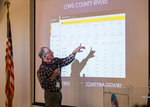
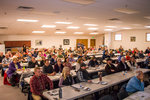


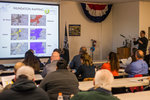

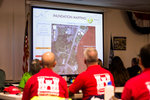
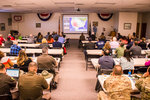
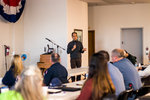
Warmer temperatures and normal-to-below-normal precipitation levels were forecasted by a National Weather Service rep at Tuesday’s annual pre-flood preparation meeting at The Veterans Memorial Museum in Chehalis, but the encouraging outlook didn’t rule out the occurrence of forthcoming storms that could lead to flooding conditions.
While issuing his winter preview, National Weather Service Senior Service Hydrologist Brent Bower predicted a pattern of neutral conditions over the rest of the week and a positive projection extending into the early portion of the winter, from October through December, and the back end of the season, from January through March.
“So, the seasonal averages are not what impacts us usually; it’s these individual events. They can happen regardless of El Niño-La Niña (weather patterns), regardless of the outlook. These individual events are the big impacts and why we do what we do,” said Bower, who reminded the capacity crowd of last year’s February snowstorm despite similar projections in 2018.
Impacts in the form of flooding conditions in the local area, he maintained, are associated with short-duration storm systems that can’t be foreseen months ahead of their arrival.
The list of speakers at the information session also featured Lewis County Manager Erik Martin, who provided an update on the Chehalis River Flood Reduction Project, which includes bolstering the levee around the Chehalis-Centralia Airport and the addition of a large water retention facility in the upper reaches of the Chehalis Basin, near Pe Ell.
Martin— who serves as the administrator of the Chehalis River Basin Flood Control Zone District— reported that two seperate EIS (Environmental Impact Statement) reports on the proposed dam are “underway” on the part of the State Department of Ecology and the U.S. Army Corps of Engineers.
As part of that effort, both agencies have formally requested clarification from Martin on several aspects of the proposed water retention dam structure that will be equipped with an available flood storage capacity of 65,000 acre-feet at completion.
In fulfilling state and federal requests for a statement of purpose and need from flood control zone district, Martin said the facility will effectively reduce flood stage throughout Chehalis Valley during major flood events.
The facility, he added, would detain flood water “very occasionally” and would not regulate or detain water during typical annual high flow events.
“A lot of people refer to it as a dam, we call it a water retention facility because it’s not like any other dam you’ve ever seen,” said Martin. “It doesn’t have any hydroelectric power (and) it doesn’t have a static reservoir behind it. It pretty much acts as a flow-through facility that the river runs right through the bottom of about 99 percent of the time.”
He proceeded to show the audience how the water retention structure would work by narrating a graphical representation of a 100-year flood event entering the facility. Martin noted the regulation of flow along with a reservoir building up behind the dam during the computer-generated demonstration.
“One of the key things people ask or think about is: Is this going to eliminate flooding? No, it’s not. What it’s going to do is drastically reduce flooding in those areas,” he explained. “Look at it this way, if you have a house in Chehalis and maybe you were 3 or 4 feet underwater during the 2007 flood, with this facility you might be down to a half-foot. So, now you have a chance to sandbag, a chance to protect your property— you have a chance.”
When touching on the proposed construction schedule, Martin reported that the completion of the facility would require approximately 5 years. An actual timeline, it was noted, will depend on seasonal timing of the Notice to Proceed, which occurs after permitting is in place.
As for the next step in the process, Martin pointed out that following the state’s publishing of a Draft EIS, there will be two late-March, early-April public meetings — one in the Chehalis-Centralia area and one in Montesano — that will give residents an opportunity to read the statement and comment on it.
Also on hand were Kimball Ohsiek and Mike Wevodau from the U.S. Army Corps of Engineers, who discussed their agency’s work to provide pumps, sandbags and other flood-fighting supplies. They advised listeners to call their hotline at 206-764-3406 during a flood event.
Scott Boettcher from the Chehalis River Basin Flood Authority offered a presentation of his agency’s flood warning system email alerts about rising river levels from local gage sites, including the Chehalis River below Thrash Creek, the Newaukum River near Chehalis and the Skookumchuck River, among other locations.
He distributed sign-in sheets instructing residents how to get on the alert database by emailing Boettcher at scottb@sbgh-partners.com or Warning System Technical Consultant Dave Curtis at dcurtis@westconsultants.com.
“The flood warning system is an opportunity for you to monitor what’s going on out there in the basin itself and make decisions yourself if you want to move stuff out of your basement,” said Boettcher. “At the end of the day, we don’t want to be surprised by what’s happening.”